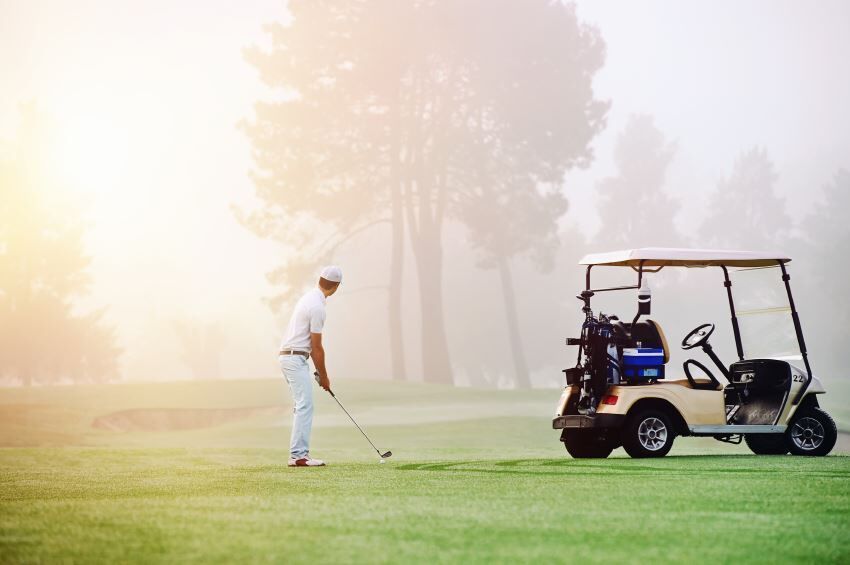Golf Tips for Hitting Irons With No Offset
Updated May 5, 2009

Offset irons are usually designed with high-handicappers in mind. "Offset" simply means that the face of the club is set back slightly from the shaft. This allows a precious few extra milliseconds for a golfer to square the blade and hit a solid shot, avoiding a slice. However, many players don't like offset irons because they limit the number of shots a good golfer can hit. Hitting irons with no offset is more demanding, but learning to do it will add variety to your game.
Instructions
Difficulty: Moderate
- Consider the design of the irons. Irons with no offset come in a range of styles, from very forgiving cavity-backs to basic forged blades. In all cases, however, you will need to use good technique to square the clubface and hit solid shots.
- Focus on compressing the ball. It's hard to hit good iron shots with non-offset irons if you fail to properly compress the ball at impact. This is achieved by hitting down on the ball, squaring the clubface and leading with the hands. When you hit the ball, the shaft must be leaning toward the target. This produces spin and a boring trajectory that helps the ball stay on line.
- Study your divots. Irons without offset tend to lack the wide soles of offset irons. Wider soles, combined with a rounding of the bottom of the club called "bounce," allow offset irons to produce good shots without taking a real divot. Non-offset irons are designed to take a divot, however. If you aren't taking one, you're not hitting down through the ball. The depth and direction of the divot can tell you a lot about how you're striking the ball. You want a divot that's not too deep and that points more or less straight.
- Experiment with opening and closing the face through impact. This is advanced, but irons with no offset allow golfers to "work" the ball with a drawing or fading ball flight. They also make it easier to hit the ball high and low. Once you've mastered good club--ball contact, you can try to close the face a bit through impact to hit a draw or leave it slightly open to promote a fade.
- Make a full turn and a full follow-through for normal shots. Offset irons are designed with weaker players in mind. Non-offset irons, on the other hand, are designed for players who can execute a full golf swing, rotating their bodies away from the ball on the backswing and through to a full finish on the follow-through. Swinging just with the arms won't create good iron shots. You have to get your body into it.
Advertisement
Tips & Warnings
- Consider using clubs with some offset for the long irons. Many good players and professionals use slightly offset 2, 3 and 4 irons. These clubs can be hit with a more sweeping motion and will cause the ball to fly higher and land softer than irons with no offset. Some irons sets designed for better players include long irons and even mid-irons that are slightly offset. There are many styles of irons between offset and non-offset. Very good players may gravitate toward simple blades, which can be challenging to hit consistently, while other players may enjoy the forgiveness that cavity-backs can provide.
- Consider using clubs with some offset for the long irons. Many good players and professionals use slightly offset 2, 3 and 4 irons. These clubs can be hit with a more sweeping motion and will cause the ball to fly higher and land softer than irons with no offset. Some irons sets designed for better players include long irons and even mid-irons that are slightly offset.
- There are many styles of irons between offset and non-offset. Very good players may gravitate toward simple blades, which can be challenging to hit consistently, while other players may enjoy the forgiveness that cavity-backs can provide.
- Depending on the design of your irons, clubs without any offset can produce bad shots if you swing down too steeply. Offset irons are usually designed to compensate for excessively steep swings, but non-offset irons' reward is a more precise strike, with the clubface coming into the ball at a shallower angle. You still want to hit down and have the shaft leaning toward the target; you just don't want to smash down. Golfers who naturally draw or hook their irons will probably favor irons without offset.
- Depending on the design of your irons, clubs without any offset can produce bad shots if you swing down too steeply. Offset irons are usually designed to compensate for excessively steep swings, but non-offset irons' reward is a more precise strike, with the clubface coming into the ball at a shallower angle. You still want to hit down and have the shaft leaning toward the target; you just don't want to smash down.
- Golfers who naturally draw or hook their irons will probably favor irons without offset.